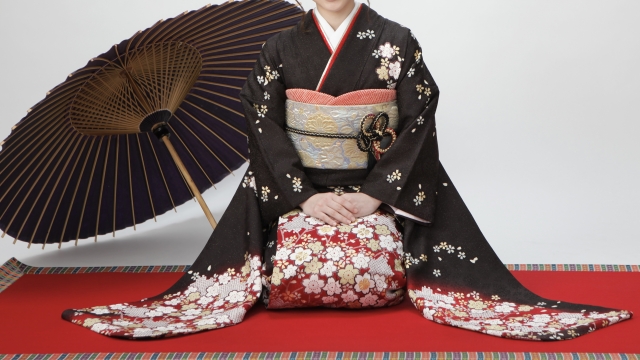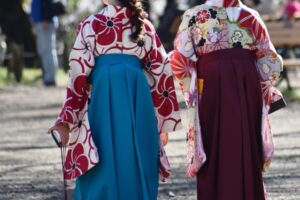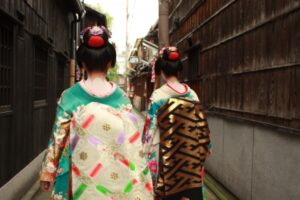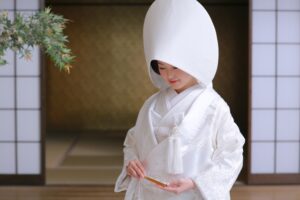成人式や結婚式で、その場を華やかに彩る振袖。その美しい出で立ちは、多くの人の目を惹きつけます。しかし、なぜ振袖が「未婚女性の第一礼装」とされているのか、その理由を深くご存知でしょうか。実は、あの優雅に揺れる長い袖には、見た目の美しさだけではない、日本の豊かな歴史と文化、そして子を想う親の切なる願いが織り込まれているのです。
- 江戸時代の粋な恋愛作法から生まれた、愛情を伝える「サイン」としての袖。
- 結婚を機に袖を短くする「留袖」に込められた、人生の新たな門出への決意。
- 単なる飾りではない、袖を振る行為に宿る「厄払い」と「良縁」への祈り。
華麗なる振袖、そのルーツは江戸の舞姫
振袖の直接の起源は、江戸時代に遡ります。もともと、脇の部分に「振り八つ口」という切れ込みがある着物は、体温が高い子供のためのもので、男女問わず着用されていました。しかし、江戸時代前期、当時人気のあった踊り子たちが、舞台上で所作を美しく見せるために袖を長くした衣装を着ていたことから、その華やかさが若い女性たちの間で大流行します。
次第に袖丈は長くなり、デザイン性も追求されるようになりました。しかし、これほど長い袖は、日常の動作には向きません。その非実用性ゆえに、振袖は次第に普段着ではなく、お祝いの席などで着る「特別な晴れ着」としての地位を確立していったのです。そして明治時代以降、未婚女性が着用する最も格式の高い礼装、すなわち「第一礼装」として社会に定着しました。
なぜ結婚すると袖が短くなるのか?留袖に秘められた誓い
未婚女性の第一礼装が振袖である一方、既婚女性の第一礼装は「留袖」です。この二つの着物の最も大きな違いは、その名の通り袖の長さにあります。かつて、女性は結婚すると振袖の長い袖を短く仕立て直す習慣がありました。
この習慣には、二つの大きな意味が込められています。一つは、家事などを行う上で長い袖は邪魔になるという実用的な理由。そしてもう一つは、より深い文化的な意味合いです。江戸時代、振袖の袖を振る仕草は、異性への求愛のサインとして使われていました。結婚した女性は、もはや他の男性に想いを伝える必要がありません。そのため、「袖を留める」ことで、夫以外に心を動かさないという貞淑の証としたのです。
ちなみに、「袖を切る」という言葉は「縁を切る」に繋がるため縁起が悪いとされ、「袖を留める」という美しい言葉が使われるようになったと言われています。現代でも恋愛で使われる「振る」「振られた」という言葉の語源が、この振袖の風習にあるのは非常に興味深いですね。
袖に宿る神秘の力?振袖に込められた祈り
振袖の長い袖は、単なるデザインや恋愛の道具ではありませんでした。そこには、目には見えない力を信じる、古来からの日本の信仰が息づいています。日本では古くから「振る」という行為には、神様を呼び寄せ、厄を祓い、場を清める力があると信じられてきました。これを「魂振り(たまふり)」と言います。神社の神主さんがお祓いで玉串を振ったり、拝殿で鈴を鳴らしたりするのも、この魂振りの一種です。
つまり、振袖の長い袖を振ることは、厄を払い、人生の門出を清めるという意味を持っていたのです。特に、女性の最初の厄年が19歳であることから、成人を迎える女性が振袖を着ることは、厄払いの儀式としての側面も持っていました。美しく長い袖を揺らしながら歩く姿は、本人の知らないところで、自らの幸せと良縁を祈願する神聖な行為でもあったのです。

現代に受け継がれる伝統の心
時代が移り、生活様式が大きく変わった現代においても、振袖は成人式や卒業式、結婚式のお呼ばれといったハレの日の衣装として、未婚女性の門出を祝い、その場に華を添える大切な役割を担っています。その背景には、単なる慣習としてだけではなく、我が子の健やかな成長と輝かしい未来を願う、親から子への変わらぬ愛情が受け継がれているからに他なりません。
解説ポイント①:江戸時代の粋な恋愛作法から生まれた、愛情を伝える「サイン」としての袖
江戸時代、男女が自由に言葉を交わすことがはばかられた時代において、振袖の袖は非常に重要なコミュニケーションツールでした。言葉にしなくとも、袖の振り方一つで細やかな感情を伝えることができたのです。
- 袖を左右に振る: 「好きです」「あなたを受け入れます」という肯定的なサイン。
- 袖を前後に振る: 「嫌いです」「ごめんなさい」という否定的なサイン。
このように、袖は未婚女性にとって、自らの意思を示すための大切な役割を持っていました。男性側も、女性が振袖を着ていることで「未婚である」と一目で分かり、アプローチのきっかけとすることができたのです。結婚して留袖を着るということは、こうした恋愛の舞台から降り、一人の男性に添い遂げるという社会的な意思表示でもありました。
解説ポイント②:結婚=人生の門出。袖を短くする「留袖」に込められた、人生の新たな門出への決意
振袖の袖を「留めた」ものが留袖であり、既婚女性の第一礼装です。留袖には大きく分けて「黒留袖」と「色留袖」の二種類が存在します。
- 黒留袖: 地色が黒で、裾部分にのみ華やかな模様(裾模様)があしらわれた、最も格式の高い着物です。背中、両胸、両外袖に合計五つの家紋を入れる「五つ紋」が正式で、主に新郎新婦の母親や祖母、仲人夫人が結婚式で着用します。
- 色留袖: 黒以外の地色を持つ留袖で、紋の数(五つ、三つ、一つ)によって格式が変わります。五つ紋を入れれば黒留袖と同格になり、紋が少なければ準礼装として、結婚式に招待された親族や主賓、パーティーなどで幅広く着用できます。
振袖が未婚時代の華やかさの象徴であるならば、留袖は新たな家庭を築き、それを支えていくという落ち着きと品格、そして決意を象徴する着物であると言えるでしょう。
解説ポイント③:単なる飾りではない、袖を振る行為に宿る「厄払い」と「良縁」への祈り
振袖の袖を振る行為が「厄払い」に繋がるという考えは、日本の「魂振り(たまふり)」という信仰に基づいています。古来、人々は振るという動作によって魂を揺り動かし、活力を得たり、神の力を呼び込んだりできると信じていました。
この信仰は現代にも様々な形で残っています。
- 神社の鈴: 参拝者が鈴を鳴らすのは、その音と振動で神様を呼び、自らを清めるためです。
- 神輿(みこし): 祭りで神輿を激しく揺さぶるのは、神の力を高め、地域に活気とご利益をもたらすためとされています。
成人式で多くの女性が振袖を着るのは、18歳〜20歳という年齢が、女性の最初の厄年(数えで19歳)と重なる時期であることが大きく関係しています。人生の大きな節目に、振袖の長い袖を振ることで厄を払い、身を清めて大人の仲間入りをする。そして、その清められた身で良縁を引き寄せる。振袖には、そんな先人たちの深い祈りと知恵が込められているのです。
参考文献
- なぜ未婚は振袖? | きものレンタリエのきもの豆知識
- 振袖の袖はなぜ長い?3つの理由&ぴったりの長さを見つけるコツをご紹介 – 林屋
- 振袖とは?種類や由来、袖が長い理由を解説! – My振袖
- 振袖 – Wikipedia
- 女性を優雅に魅せる振袖と成人式の歴史 – 振袖のレンタル・購入なら【公式】京都きもの友禅
【English Article】
Why Only Unmarried Women Wear Furisode? The Japanese Spirit Woven into the “Sleeves”
At coming-of-age ceremonies and weddings, the furisode kimono brightens the occasion with its vibrant beauty, captivating all who see it. But have you ever wondered why the furisode is considered the premier formal attire exclusively for unmarried women? The truth is, those elegantly swaying long sleeves carry more than just visual appeal; they are woven with Japan’s rich history, culture, and the heartfelt wishes of parents for their children.
- Born from the stylish courtship customs of the Edo period, the sleeves served as a “sign” to convey affection.
- The tomesode, with its shortened sleeves, symbolizes a new beginning in life, a resolution made upon marriage.
- More than mere decoration, the act of waving the sleeves holds prayers for “warding off evil” and “inviting good fortune.”
The Splendid Furisode: Roots in the Dancing Maidens of Edo
The direct origins of the furisode date back to the Edo period (1603-1868). Initially, kimono with openings under the armpits, known as furi-yatsuguchi, were practical garments for children, who have higher body temperatures, and were worn by both boys and girls. However, in the early Edo period, professional dancers began wearing costumes with elongated sleeves to make their movements appear more graceful on stage. This glamorous style became a massive trend among young women.
Sleeve lengths gradually grew longer, and designs became more elaborate. However, such long sleeves were impractical for daily activities. Because of this impracticality, the furisode evolved from everyday wear into “special occasion attire” for celebrations. From the Meiji period (1868-1912) onward, it became firmly established in society as the most formal attire, or dai-ichi reisō, for unmarried women.
Why Do Sleeves Get Shorter After Marriage? The Vow Hidden in the Tomesode
While the furisode is the primary formal wear for unmarried women, the tomesode holds that honor for married women. The most significant difference between these two kimono is, as the names suggest, the length of the sleeves. Historically, it was customary for women to shorten the long sleeves of their furisode after getting married.
This tradition held two important meanings. The first was practical: long sleeves were a hindrance to household chores. The second was more culturally profound. In the Edo period, the gesture of waving one’s furisode sleeves was used as a sign of courtship toward the opposite sex. A married woman no longer needed to express her feelings to other men. Therefore, by “fastening the sleeves” (tome-sode), she demonstrated her fidelity and devotion to her husband.
Interestingly, the phrase “to cut the sleeves” (sode o kiru) was avoided as it sounds like “to cut ties” (en o kiru), which is considered inauspicious. Instead, the more elegant term “to fasten the sleeves” (sode o tomeru) was used. It’s fascinating that the modern Japanese dating terms furu (to reject) and furareta (to be rejected) originate from this very furisode custom of waving (furu) the sleeves.
Mystical Power in the Sleeves? Prayers Woven into the Furisode
The long sleeves of a furisode were not just for design or romance. They are imbued with ancient Japanese beliefs in unseen forces. Since ancient times, the act of “waving” or “shaking” things—a practice known as tamafuri (spirit shaking)—was believed to have the power to summon deities, exorcise evil spirits, and purify a space. The ringing of bells at a shrine or a Shinto priest waving a sacred branch (tamagushi) during a purification ritual are both forms of tamafuri.
Thus, waving the long sleeves of a furisode was an act meant to ward off misfortune and purify oneself for life’s milestones. This was particularly relevant as a woman’s first unlucky year (yakudoshi) is traditionally age 19. Wearing a furisode for the coming-of-age ceremony, therefore, also served as a purification ritual. The sight of a young woman walking with her long, beautiful sleeves swaying was, unbeknownst to her, a sacred act of praying for her own happiness and good fortune.
A Tradition Passed Down to the Modern Day
Even as times and lifestyles have drastically changed, the furisode continues to hold its important role as celebratory attire for unmarried women on special “hare no hi” (sunny, celebratory days) like coming-of-age ceremonies, graduations, and as a guest at weddings. It endures not merely as a custom, but because it embodies the timeless love of parents, who pass down their wishes for their children’s healthy growth and bright future.
Analysis Point ①: Born from the stylish courtship customs of the Edo period, the sleeves served as a “sign” to convey affection
In an era when open conversation between men and women was often discouraged, the sleeves of the furisode were a crucial communication tool. Without uttering a word, one could convey subtle emotions simply by how the sleeves were waved.
- Waving the sleeves side to side: A positive sign, meaning “I like you” or “I accept your feelings.”
- Waving the sleeves back and forth: A negative sign, meaning “I don’t like you” or “I’m sorry.”
Thus, the sleeves played a vital role for an unmarried woman to express her intentions. For men, the sight of a woman in a furisode was an instant indicator that she was “unmarried,” providing an opening for courtship. To marry and wear a tomesode was a social declaration of stepping off this stage of romance and committing to one person.
Analysis Point ②: Marriage as a New Beginning: The Resolution in the Shortened Sleeves of the Tomesode
The tomesode, born from “fastening” the furisode’s sleeves, is the premier formal kimono for married women. There are two main types: the kuro-tomesode (black tomesode) and the iro-tomesode (color tomesode).
- Kuro-tomesode: The most formal type of kimono, it is solid black with an ornate pattern only along the hem. It is formally decorated with five family crests (itsutsu-mon): one on the back, one on each side of the chest, and one on each outer sleeve. It is primarily worn by the mothers, grandmothers, and official matchmakers of the bride and groom at a wedding.
- Iro-tomesode: A tomesode in any color other than black. Its formality varies depending on the number of crests (five, three, or one). With five crests, it is equal in formality to the kuro-tomesode. With fewer crests, it serves as semi-formal wear, suitable for a wider range of occasions, such as for relatives and honored guests at weddings or for formal parties.
If the furisode is a symbol of the splendors of one’s unmarried years, the tomesode can be said to symbolize the grace, dignity, and resolve to build and support a new family.
Analysis Point ③: More Than Decoration: The Prayers for “Warding Off Evil” and “Inviting Good Fortune” in Waving the Sleeves
The idea that waving furisode sleeves can ward off evil is rooted in the Japanese belief of tamafuri (spirit shaking). Ancient people believed that the act of shaking could stir the soul, invigorating it and drawing in divine power.
This belief persists in various forms today:
- Shrine Bells: Worshippers ring large bells to call upon the gods and purify themselves with the sound and vibration.
- Mikoshi (Portable Shrines): During festivals, mikoshi are shaken vigorously to amplify the power of the deity within, bringing vitality and blessings to the community.
The custom of wearing furisode at coming-of-age ceremonies is closely linked to the fact that the ages of 18-20 coincide with a woman’s first traditional unlucky year (19 by traditional Japanese age reckoning). At this major life turning point, by waving the long sleeves of her furisode, a young woman ritually purifies herself and wards off evil as she enters adulthood. It was believed that with this purified self, she could attract a good marital match. The furisode is imbued with the deep prayers and wisdom of our ancestors.











コメントを残す